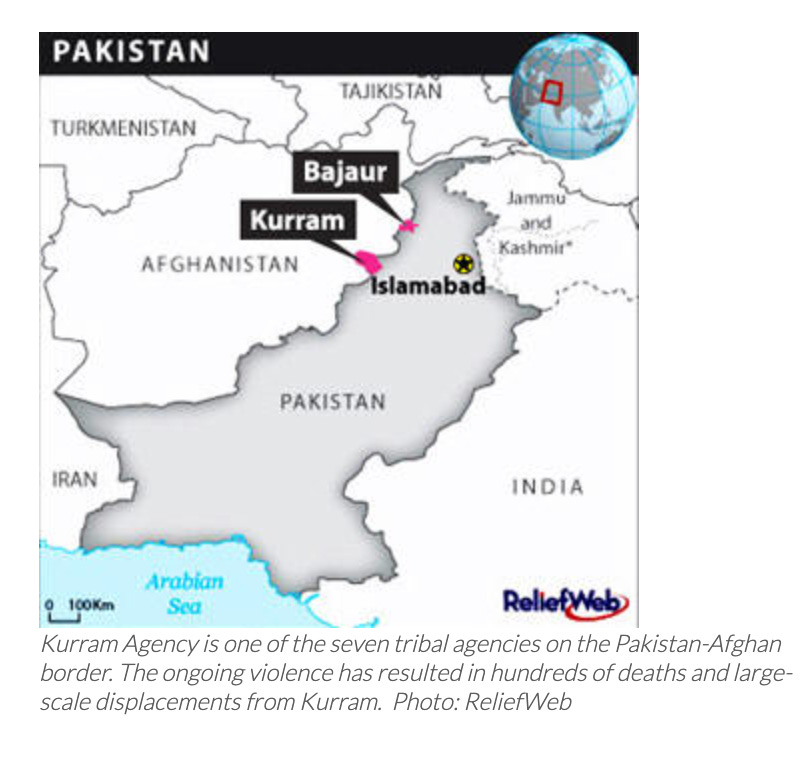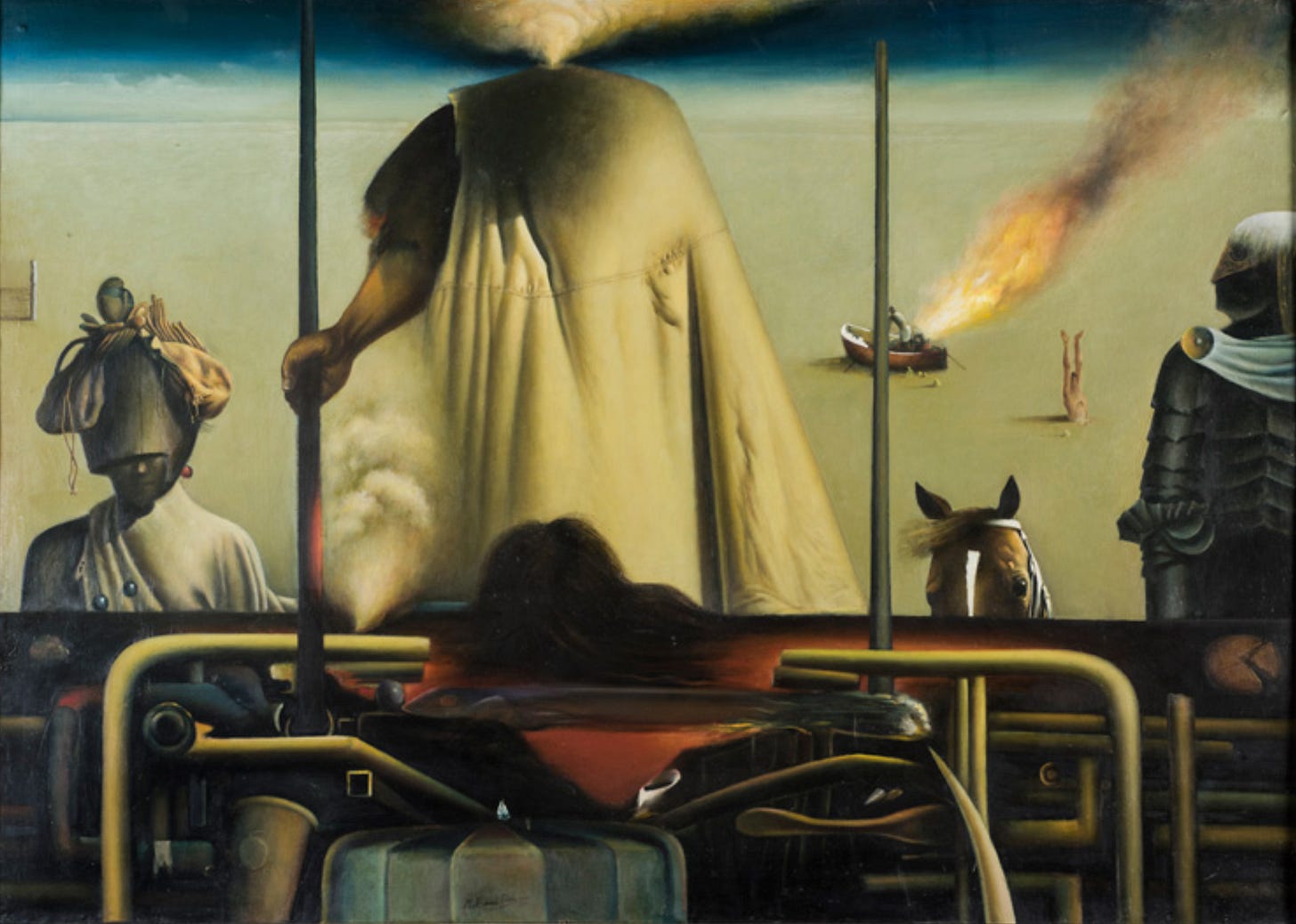The Credit Suisse Nazi cover-up. Global bond tremors. The Atlas of drowned towns & Eric Dolphy's last date.
Great links, images, and reading from Chartbook Newsletter by Adam Tooze
Thank you for opening your Chartbook email.
Mohamed Riyad Saeed (Egyptian, 1938-1965). “Adams Apple.” Source: Universes in Universe
The Credit Suisse Nazi cover-up
The American blacklist stamp, provided by Neil Barofsky to the Senate Budget Committee.
Switzerland thought it came to terms with its Nazi-assisting past after harrowing probes in the 1990s led its two largest banks to pay more than $1 billion restitution to Holocaust victims. Documents unearthed in bank archives show it might have been at least in part a whitewash. A cache of client files stamped “American blacklist,” a designation for those financing or trading with Nazis or Axis partners, was recently found by independent investigators probing Credit Suisse, one of Switzerland’s biggest banks and now part of UBS In the 1990s, two panels studied Swiss banks’ World War II-era activities after anger erupted over Holocaust victims’ unreleased funds. But the investigators now taking a fresh look found Credit Suisse withheld crucial information. They located several Nazi-linked accounts that were discovered by the bank in the 1990s but never disclosed to investigators. They also turned up new details of an operational account controlled by high-ranking Nazi SS officers and a Swiss intermediary that was allegedly used to move and store looted assets. The findings came to light in a probe overseen by an independent ombudsman, Neil Barofsky. The former U.S. prosecutor, who is a partner at law firm Jenner & Block, was hired by Credit Suisse in 2021 after the Simon Wiesenthal Center found information on possible Nazi clients that hadn’t previously been disclosed. The Senate Budget Committee got involved two years ago, when Credit Suisse fired Barofsky from the probe. Bank executives played down what he had found and felt he had overstepped lines it wanted around the investigation. The committee has jurisdiction over the State Department’s Office of the Special Envoy for Holocaust Issues, which seeks to secure compensation for Nazi-era wrongs.
Barofsky was reinstated in late 2023, following UBS’s emergency rescue of Credit Suisse. In a December 2024 letter to the Senate, reviewed by The Wall Street Journal, Barofsky said Credit Suisse and new owner UBS have fully opened their archives and have assigned more than 50 people to work on the probe. “The investigation has identified scores of individuals and legal entities connected to Nazi atrocities whose relationships with Credit Suisse had either been previously unidentified, or for which the relationship had been partially identified but the full nature of the bank’s involvement has not yet been reported publicly,” Barofsky wrote in the letter.
Buried in storage were around 3,600 boxes from the “Inf department” containing information about clients, including ones who were on the U.S. wartime blacklist for furthering the Nazi cause. Barofsky described the Inf department files as akin to “know your customer” details that banks keep on their clients. A preliminary search against 99 known Nazis and affiliates produced 13 name matches. Numerous files bore the American blacklist stamp, he said, which his team hadn’t seen before in other Credit Suisse archives. Some portions of the Inf department files were included in earlier reviews but were never scanned, indexed or systematically incorporated into those probes, Barofsky said in the letter to Congress. That work is now ongoing. … Internal comments by bank executives in the 1990s on one of the panel’s draft reports said the report was “rather sanitized,” but best left as is. Credit Suisse’s general approach to outside investigations was to share only requested information and not offer additional insights, Barofsky said his team was told. Key information and relevant accounts weren’t shared then with the outside panels, including information about the account controlled by officers of the Nazi SS—Adolf Hitler’s elite paramilitary unit—and a Swiss intermediary.
Source: Margot Patrick in WSJ
What is wrong in global bond markets?
But market pricing suggests something else is also at play. Worries about price rises are not—at least outside Japan—showing up in rising expectations as measured by inflation derivatives (financial contracts with pay-offs determined by price readings). In America, Britain and the euro area such inflation expectations have fallen in recent weeks. Investors seem to believe the economy has more inflationary pressure than previously supposed, but also that central banks, in the most likely scenario, will be able and willing to contain price rises with more hawkish monetary policy. Instead, the most significant change concerns increased uncertainty in investors’ expectations. This could be pushing up the “term premium”—the additional yield investors charge on long-term government bonds, over and above that attributable to the changes in the central bank’s policy rate that are already expected. The term premium compensates bondholders for the risk that bond prices fall sharply, say if unexpected inflation forces central banks to aggressively raise rates. Indeed, increases in the premium on ten-year Treasury yields account for almost all the increase in these yields since early December (see chart 2). … Bear in mind that, although the term premium has risen, it remains nowhere near the levels of the past. After high inflation and rapidly rising interest rates during the 1970s and 1980s, which ravaged the real value of bond portfolios, investors shunned government debt. Well into the 2000s, the term premium was measured in full percentage points, rather than the tenths of today. Imagine that investors are mistaken about the odds of central banks cutting interest rates this year, and policymakers are instead forced to start raising them again. In such a scenario, investors would have ample reason to shun sovereign bonds. If they do, there is plenty of room for yields to rise even further.
Source: The Economist
HEY READERS,
THANK YOU for opening the Chartbook email. I hope it brightens your weekend.
I enjoy putting out the newsletter, but tbh what keeps this flow going is the generosity of those readers who clicked the subscription button.

If you are a regular reader of long-form Chartbook and Chartbook Top Links, or just enthusiastic about the project, why not think about joining that group? Chip in the equivalent of one cup of coffee per month and help to keep this flow of excellent content coming.
If you are persuaded to click, please consider the annual subscription of $50. It is both better value for you and a much better deal for me, as it involves only one credit card charge. Why feed the payments companies if we don’t have to!
And when you sign up, there are no more irritating “paywalls”
Understanding the Surge in Bond Yields: Term Premium, not “higher for longer”
For contributing subscribers only.
“A rabble of ignorant tech bros”: When Alan Beattie gets the knife out!
Trump (with a Republican Congress) is highly unlikely to become the first fiscally conservative Republican president since Dwight Eisenhower and deliver a tighter-fiscal-looser-monetary policy mix. He wants to extend expiring tax cuts from his first administration and add more. The non-partisan Tax Foundation research organisation says that, even factoring in tariff revenue from a massive 20 per cent tariff on all imports plus a hike of 50 per cent on those from China, these cuts will cost around $3tn over 10 years — that’s just over 10 per cent of one year’s GDP. Supposedly offsetting or even outweighing those cuts is a streamlining programme by the Doge (Department of Government Efficiency) project co-run by Elon Musk. But if you expect feasible and sustainable spending control from a rabble of ignorant tech bros crashing round the federal bureaucracy, I’ve got a cryptocurrency-financed artificial intelligence-designed bridge from Mar-a-Lago to Greenland to sell you. Musk’s men are less likely to engineer a smoothly purring Rolls-Royce of a federal government than build a rusty Cybertruck with a flat battery. Before Doge has even started, Musk has already cut its annual target savings in half, from a delusional $2tn to having a “good shot” at a merely quixotic $1tn.
Source: Alan Beattie in FT
Paul Krugman on writing for the New York Times
“I approached Mondays and Thursdays with dread,” Krugman continued, “and often spent the afternoon in a rage. Patrick often—not always—rewrote crucial passages; I would then do a rewrite of his rewrite to restore the original sense, and felt that I was putting more work—certainly more emotional energy—into repairing the damage from his editing than I put into writing the original draft. It’s true that nothing was published without my approval; but the back-and-forth, to my eye, both made my life hell and left the columns flat and colorless.” Healy denied he had done anything to muffle Krugman’s voice. “He never called or emailed me saying I was changing his meaning or censoring his views, and he never lodged an objection to me that I overrode,” Healy wrote in his email to CJR. Healy added that Krugman was one of “our strongest voices studying, explaining and warning about the dangers of Trump’s economic plans and policies in 2024, and he used language and built arguments that were memorably searing about Trump’s ‘lies’ and ‘lying,’ ‘radical’ plans, ‘Trumpflation’ approach, and ideas that would ‘wreck our economy.’” Krugman replied, “I guess it’s he said, he said. Despite my attempts to convey my unhappiness, they may not have realized just how much my experience had been degraded.”
Source: Charles Kaiser in Columbia Journalism Review
The making of Peter Navarro (Gillian Tett)
For contributing subscribers only.
Mohamed Riyad Saeed (Egyptian, 1938-1965). “The Guard,” (1970s). Source: Egypt Today
The Narratives of War in Pakistan’s Kurram District by Hassan Turi
The district of Kurram, in Pakistan’s northwestern tribal region, has been under siege for the past three months due to the closure of the main Thal-Parachinar Road, a key route connecting the region to the rest of the country. Besieged communities in the district have been facing severe shortages of essential supplies, including food and medicine. The road has been closed since late November, when sectarian violence broke out in Kurram. The first three days of fighting killed more than 80 people. A series of sit-ins were organized across the country, including in Karachi, to show solidarity with rival sects. Similarly, a delegation of Pashtun elders, formed during the Pashtun Tahafuz Movement (PTM)’s October national jirga, visited the district and held meetings with elders from the rival Sunni and Shia tribes. However, the delegation returned without achieving any fruitful results. Recently, the government succeeded in signing a fragile peace agreement between the warring tribes after weeks of bloodshed that claimed around 130 lives, raising cautious hopes for stability in this historically volatile region. Authorities had placed their hopes on a government-protected convoy scheduled for January 4. The convoy was tasked with delivering essential supplies to the besieged communities. Its successful passage was expected to provide much-needed relief and signal the possibility of reopening the road for future movement – a critical lifeline for the region. … After intense violence between 2007 and 2011, Kurram enjoying a lull of several years. However, the security situation in the district has steadily deteriorated since the merger of the former Federally Administered Tribal Areas (FATA) into Khyber Pakhtunkhwa province in 2018. … Unfortunately, the optimism surrounding the merger was short-lived. Instead, the merger prompted a new wave of violence around disputed lands generally throughout the former tribal region and more specifically in the district Kurram. Disputes over the communal lands among rival Sunni and Shia tribes soon engulfed the whole district. These intermittent clashes over land disputes would be followed with sit-ins and protests in their respective towns. The disputes over the land between rival tribes’ villages were transformed deliberately into sectarian conflicts via these sit-ins and protests. While Kurram grappled with the resurgence of internal land-related conflicts, the broader former FATA region witnessed the re-emergence of Tehreek-e-Taliban Pakistan (TTP)-led attacks. These attacks, originating from neighboring Afghanistan, intensified following the Taliban’s takeover of Afghanistan after the collapse of Ashraf Ghani’s government in 2021. The spillover effects of this regime change were acutely felt in Kurram, where TTP activities surged dramatically. … In the case of Kurram, the Pakistani government has largely failed to rehabilitate displaced populations in their respective villages. Many Sunni tribes displaced from Upper Kurram due to violence since 2007, as well as Shia communities expelled from Sadda in the 1990s, remain unsettled. This failure to address resettlement has deepened existing grievances and fueled ongoing disputes. The government has also failed to arrange a prompt land policy to cope with land-related disputes. The Pakistani state introduced Alternative Disputes Resolution jirgas to deal with land disputes, but they remained unsuccessful. This failure of state institutions has led to widespread accusations of bias, with claims that the state favors one community over another. Disparities in the recognition of ownership and victimhood claims have increased tensions further. …. Despite the severity of the violence in Kurram, the provincial government seemed to deprioritize addressing the crisis. Instead, it directed its attention toward organizing large-scale protests in Islamabad, demanding the release of PTI’s jailed founder, Imran Khan. The unrest in Kurram, with its humanitarian and security implications, took a back seat as political battles over Khan’s detention dominated the party’s agenda. The situation in Kurram was further politicized as opposing factions used the conflict to advance their own narratives. Critics accused the PTI-led government of ignoring the needs of a conflict-ridden region, while supporters deflected blame onto federal authorities, arguing that the central government’s policies had weakened the Khyber Pakhtunkhwa administration’s ability to govern effectively.
Source: Hassan Turi in The Diplomat
The Business of History Is Booming, Will Dunn
Google’s Ngram viewer, which covers printed sources up to 2022, suggests a significant increase in writing about history over the past decade. Historians are reaching huge audiences via email newsletters — Boston College history professor Heather Cox Richardson is one of Substack’s most successful authors, with 1.8 million subscribers — and social media. TikTok’s year-long interest in the Roman Empire, and how often men claim to think about it, has been the subject of more than 85 million videos. It is in podcasts, however, that history has the greatest success. The Rest is History competes with Hardcore History, Revisionist History, The History of Rome, Stuff You Missed in History Class, Tides of History, History Hit and hundreds more to satisfy the public’s seemingly insatiable appetite for amiable discourse about war, monarchy, empire, plague and revolution.
Source: Will Dunn in Bloomberg
The Atlas of Drowned Towns
Source: The Atlas of Drowned Towns
Exploring Submerged Resilience: The Atlas of Drowned Towns
Submerged under the reservoirs for large dams lie the remains of displaced communities that reveal the depths of “resilience.” Exploring the histories of such places brings to the surface not only a wide spectrum of resistance (the most common yet most limited definition of “resilience”) but also resilience in two forms: (1) an insistence on the value of inundated communities and the perspectives of people who call them home, and (2) the persistence of such places and people. These ideas have emerged out of the Atlas of Drowned Towns (drownedtowns.com). This digital public history project creates processes and spaces in which communities affected by dam-induced displacement can participate in finding, remembering, and making sense of the histories of such places. Currently under development with a focus on thirteen dams in Oregon’s Willamette Valley, the project’s processes include community outreach, engagement, and archiving events called “History Jamborees,” which help build a digital archive that contributes to the Atlas’s website. The artifacts, stories, and memories shared with the Atlas of Drowned Towns reveal acts of resistance, insistence, and persistence in the past, and those acts of sharing and participation themselves provide opportunities to express and define resilience in the present.
Source: Bob H Reinhardt in The American Historical Review, Volume 129, Issue 4, December 2024,
Eric Dolphy, “Last Date” Documentary
Source: Directed by Hans Hylkema (1991)
Mohamed Riyad Saeed (Egyptian, 1938-1965). “20th Century Civilisation,” (1970s). Source: National Museum of Modern and Contemporary Art, Korea
If you’ve scrolled this far, you know you want to click:









